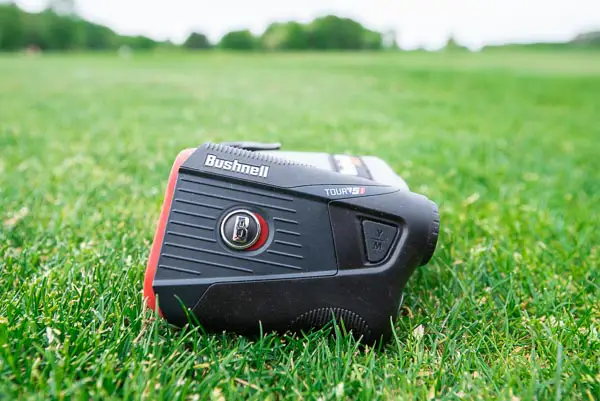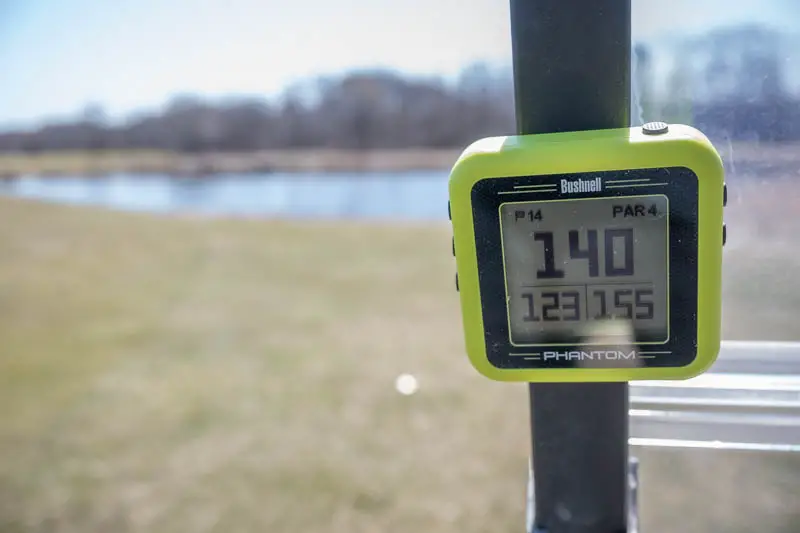The main difference between a rangefinder and GPS is that a GPS can give you yardages to a number of different spots on the course at once but can have some margin of error while a laser rangefinder requires you to have a line of sight to one specific object at a time but gives very precise yardages.
Unless you have a caddie with you for every round, you’ll need some way of getting yardages.
When I learned the game, that meant looking for yardage markers or sprinkler heads with the yardages on them and pacing off the distance to my ball.
But luckily technology has evolved since those dark days and we have very helpful devices like GPS and laser rangefinders.
But they can be pricey so if you get one, you want to make sure you’re giving yourself the best opportunity to score well. So let’s take a look at how they differ and which one might be right for your game.

Pros of a Laser Rangefinder
A laser rangefinder shoots a laser that bounces light off an object and is read by a sensor in the device to measure the distance. Because of this, their biggest benefit is accuracy. Check out our breakdown of the best golf rangefinders.
Most current rangefinders are accurate to the yard, with some companies claiming that their devices are accurate up to the fraction of a yard (which is cool, but if you’ve got enough control to know half yard increments, you probably have a caddie and your name on the bag).
Another benefit of having a rangefinder is the ability to get yardages anywhere. Even if you are out in the middle of a field trying to hit balls at a tree, you can get accurate yardage to that tree.
Practically speaking, that means that the course doesn’t have to be mapped out by anyone to get accurate yardages (although that is becoming less and less of an issue as you’ll see below when we discuss GPS).
But more importantly, that means that you can get precise yardages to flags and other landmarks on the practice range. I tend to use a rangefinder substantially more when practicing than I do on the course.
Because you can get the distance to anything, that also means that you can pick out whatever on-course target you want. As long as you can see it, most rangefinders will be able to get a yardage to it. This helps if there is a tree you want to cover for a dogleg that might not be indicated on some GPS devices.
The last benefit I’ll mention is the ability to adjust for slope. Most rangefinder brands have models that will identify targets that are above or below you and use an algorithm to give you an estimated distance that you should hit to get to that target. For example, a flag might be 150 yards away, but if it’s also 20 feet higher in elevation, then you should be taking a club that goes more than 150 yards.
But rangefinders do have their limitations, so let’s get to that now…
Cons of a Laser Rangefinder
Using a rangefinder requires you to get it out, point it at the target, press the button, and wait for the yardage. Some models are faster than others to acquire the target and distance, but they all take a few seconds at least to aim and shoot. This model was almost instant once I pressed the button, so if speed is important, check it out.
If you have shaky hands, hitting the target can take even longer and can be very frustrating. Some models have stabilization to help with this, but it’s not perfect.
Rangefinders also only shoot one target at a time. So if you are trying to strategize for a hole, you might need to laser multiple targets to see where you want to aim (assuming you can see them…more on that in a minute).
Of course, there are things you can do to minimize the effect this has on your round, like getting your yardage while you’re waiting to hit, but it can be a factor.
The other negatives to using a rangefinder all stem from the fact that you need a line of sight to your target in order to get a yardage. There are two scenarios where this becomes problematic.
First, it can be difficult to target fairway bunkers, especially if they are relatively flat. Plus, not all fairway bunkers are visible off the tee. So even if you know they are out there, you’ll end up having to estimate where they are.
Second, for blind shots, a rangefinder is mostly useless. If you can’t see the target, you can’t get a distance to it.
But if all these things don’t bother you, rangefinders also hit your wallet a little harder on average than GPS devices, with some models costing $400 or more. Of course, you don’t have to get the top-of-the-line models, but in general, they are going to be more expensive than a GPS.

Pros of Using a Golf GPS
The biggest benefit of a GPS device is that they give you vastly more information than a rangefinder.
Of course, the amount of information varies from model to model, but even the most basic like the Bushnell Phantom pictured above, will give you the front, middle, and back of the green distances as well as carry distances for fairway hazards.
More advanced models (and most smartphone apps) will have maps of the hole and let you choose any spot on the map to get a distance (in addition to displaying the common ones I mentioned above. This makes using a GPS very fast and easy. If you have it out already, then all you need to do is glance at the screen to figure out what you want to do.
You probably already own a very high-end GPS device in the form of your smartphone. There are a plethora of golf GPS apps that you can download to turn your phone into the perfect device for getting shot distances.
If you are using your phone or one of the dedicated GPS devices that show a map of each hole, they can be invaluable for planning your strategy. Knowing at a glance where everything is will make it easier and faster to form a plan. That can often result in substantially lower scores than just trying to smash it down the middle with driver on every par 4 and 5.
Some GPS devices will even track your shot yardages. If you don’t have a dedicated shot tracker like the Arccos system I reviewed, then you may have to click to enter each shot manually, but the insights you can get from knowing exactly how far you hit every club can make a massive difference in your game.
So, as you can see, the biggest strength of a GPS is in just how much information they can give you, but there are some downsides too…
Cons of Using a Golf GPS
The most commonly mentioned downside of using a GPS is the lack of accuracy.
While they are less accurate than a laser rangefinder, they are constantly improving. Many GPS devices are accurate to within a couple of yards (which is far more accurate than the average golfer!).
As the technology improves, this is bound to get better as well. One of the upsides to using a smartphone is that they often have excellent GPS technology, especially in the newest models.
Also, a golf GPS is only as good as the information in the software. This means that courses need to be mapped in some way and if you’re playing a course that isn’t mapped, you’re out of luck. But this is really becoming less and less of an issue. Many brands are using Google maps which gives you a great overhead satellite view of the hole and makes it easy for them to map out the yardages.
Since GPS distances are based on mapping of the course, they don’t take into account the pin placement for that day. So while you will be able to get the front, back, and middle of the green, you need to use your own judgment to estimate where the pin is.
Frankly, most amateur golfers would probably shoot lower scores if they ignored the pin and focused on just hitting the green. So this might be a positive if you embrace that philosophy.
Finally, some of you may just not like using electronics on the course. GPS units generally require a little more tech-savvy than a rangefinder. So if you are screen averse, then maybe a GPS isn’t the best option, although there are some excellent simple devices like the Bushnell Phantom that I reviewed.
Which One Should You Use?
Well, the easy answer is to keep both on hand. You can use the GPS for strategy and figuring out carry distances over certain hazards or decide what portion of the green you want to aim for AND use the laser rangefinder for precise distances like getting the pin distance on shorter shots or figuring out if the pin is in the front or back of the green.
But that can get expensive.
For most golfers, a GPS would be the first device I would recommend.
The reality is that even single-digit handicappers don’t need exactly precise yardages. Even on short approaches, knowing the distance to the front and back of the green is far more important than knowing whether the pin is 124 or 121 yards away.
The good news is that there are plenty of great smartphone apps that are quite affordable. So you could take the approach I use, which is to use my smartphone as a GPS and then keep the rangefinder handy for those wedge shots where you want to go pin hunting.
